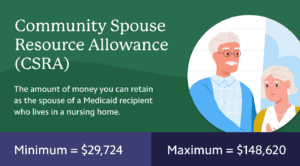 Medicaid law provides special protections for the spouses of Medicaid applicants to make sure the spouses have the minimum support needed to continue to live in the community (i.e. at home) while their husband or wife is receiving long-term care benefits, usually in a nursing home.
Medicaid law provides special protections for the spouses of Medicaid applicants to make sure the spouses have the minimum support needed to continue to live in the community (i.e. at home) while their husband or wife is receiving long-term care benefits, usually in a nursing home.
One of the most important protections is the “community spouse resource allowance” or CSRA. It works this way: if the Medicaid applicant is married, the countable assets of both the community spouse and the institutionalized spouse are totaled as of the date of “institutionalization,” the day on which the ill spouse enters either a hospital or a long-term care facility in which he or she then stays for at least 30 days. (This is sometimes called the “snapshot” date because Medicaid is taking a picture of the couple’s assets as of this date.)
In order to be eligible for Medicaid benefits a nursing home resident may have no more than $2,000 in assets (an amount may be somewhat higher in some states). In general, the community spouse may keep one-half of the couple’s total “countable” assets up to a maximum of $148,620 (in 2023). This is the community spouse resource allowance (CSRA), the most that a state may allow a community spouse to retain without a hearing or a court order. The least that a state may allow a community spouse to retain is $29,724 (in 2023).
Example: If a couple has $100,000 in countable assets on the date the applicant enters a nursing home, he or she will be eligible for Medicaid once the couple’s assets have been reduced to a combined figure of $52,000 — $2,000 for the applicant and $50,000 for the community spouse.
For more information, you can access a CMCS Information Bulletin from CMS HERE.

Recent Comments